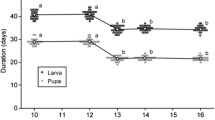Summary
Seasonal variation in mean hind tibia length and mean testes length is investigated in the yellow dung fly, Scathophaga stercoraria (L.). There is a cycle in mean hind tibia length and mean testes length over a season. The body size curve peaks later than the testes length curve, showing that there is no fixed relationship between the two variables. The causes of variation in testes size and its influence on copula duration are experimentally examined. Increasing the number of Drosophila eaten per day leads to increased mature testes length. Males with larger testes copulate for longer than males with smaller ones, and smaller males copulate for longer than do larger males. While testes shrivel with successive copulas, copula duration remains constant. The more females a male is prepared to copulate with in a day (up to five), the longer he copulates with each. The shrinkage of the testes of males collected throughout a day suggests that males copulate with an average of 4 females per day. The costs of sperm production are thus shown to have a significant influence on the copula duration.
Similar content being viewed by others
References
Bailey NTJ (1959) Statistical methods in biology. Hodder and Stoughton, London
Borgia G (1979) Sexual selection and the evolution of mating systems. In: Blum MS, Blum NA (eds) Sexual selection and reproductive competition in insects. Academic Press, New York, pp 19–80
Borgia G (1980) Sexual competition in Scatophaga stercoraria: size and density related changes in mate ability to capture females. Behaviour 75:185–206
Borgia G (1981) Mate selection in the fly Scatophaga stercoraria: female choice in a male-controlled system. Anim Behav 29:71–80
Borgia G (1982) Experimental changes in resource structure and male density: size-related differences in mating success among male Scatophaga stercoraria. Evolution 36:307–315
Dewsbury DA (1982) Ejaculate cost and male choice. Am Nat 119:601–610
Dewsbury DA, Sawrey DK (1984) Male competition as related to sperm production, pregnancy initiation, and sperm competition in deer mice (Peromyscus maniculatsu). Behav Ecol Sociobiol 16:37–47
Foster W (1967) Hormone-mediated nutritional control of sexual behaviour in male dung flies. Science 158:1596–1597
Kloet GS, Hincks WD (1975) A check list of British insects. Royal Entomological Society, London
Krebs JR, McCleery RH (1984) Optimization in behavioural ecology. In: Krebs JR, Davies NB (eds) Behavioural ecology, 2nd edn. Blackwell, Oxford, pp 91–121
Parker GA (1968) Unpublished Ph.D. thesis, University of Bristol, UK
Parker GA (1970a) The reproductive behaviour and the nature of sexual selection in Scatophaga stercoraria L. (Diptera: Scatophagidae). I. Diurnal and seasonal changes in population density around the site of mating and oviposition. J Anim Ecol 39:185–204
Parker GA (1970b) The reproductive behaviour and the nature of sexual selection in Scatophaga stercoraria L. (Diptera: Scatophagidae). II. The fertilization rate and the spatial and temporal relationships of each sex around the site of mating and oviposition. J Anim Ecol 39:205–228
Parker GA (1970c) Sperm competition and its evolutionary effects on copula duration in the fly Scatophaga stercoraria. J Insect Physiol 16:1301–1328
Parker GA (1978) Searching for mates. In: Krebs JR, Davies NB (eds) Behavioural ecology, 1st edn. Blackwell, Oxford, pp 214–244
Parker GA (1982) Why are there so many tiny sperm? Sperm competition and the maintenance of two sexes. J Theor Biol 96:281–294
Parker GA, Stuart RA (1976) Animal behaviour as a strategy optimizer: evolution of resource assessment strategies and optimal emigration thresholds. Am Nat 110:1055–1076
Ridley M, Thompson DJ (1979) Size and mating in Asellus aquaticus (Crustacea: Isopoda). Z Tierpsychol 51:380–397
Sigurjonsdottir H (1980) Evolutionary studies of seuxal dimorphism in size: studies on dung flies and three groups of birds. Unpublished Ph.D. thesis, University of Liverpool, UK
Sigurjonsdottir H (1984) Food competition among Scatophaga stercoraria lavae with emphasis on its effects on reproductive success. Ecol Entomol 9:81–90
Sigurjonsdottir H, Parker GA (1981) Dung fly struggles: evidence for assessment strategy. Behav Ecol Sociobiol 8:219–230
Simmons LW (1988) Male size, mating potential and lifetime reproductive success in the field cricket, Gryllus bimaculatus (De Geer). Anim Behav 36:372–379
Simmons LW, Ward Pl (1991) The heritability of sexually dimorphic traits in the yellow dung fly Scathophaga stercoraria. J Evol Biol (in press)
Sokal RR, Rohlf FJ (1969) Biometry. Freeman, San Francisco
Steele RH (1986a) Courtship feeding in Drosophila subobscura. 1. The nutritional significance of courtship feeding. Anim Behav 34:1087–1098
Steele RH (1986b) Courtship feeding in Drosophila subobscura. II. Courtship feeding by males influence female mate choice. Anim Behav 34:1099–1108
Steele RH, Partridge L (1988) A courtship advantage for small males in Drosophila subobscura. Anim Behav 36:1190–1197
Thornhill R (1979) Male and female sexual selection and the evolution of mating strategies in insects. In: Blum MS, Blum NA (eds) Sexual selection and reproductive competition in insects. Academic Press, New York, pp 81–122
Ward PI (1984) The effects of size on the mating decisions of Gammarus pulex (Crustacea: Amphipoda). Z Tierpsychol 64:174–184
Ward PI (1985) The marginal value theorem: an analytical solution for the optimum. Z Tierpsychol 69:340–343
Author information
Authors and Affiliations
Additional information
Offprint requests to: P.I. Ward at the second address
Rights and permissions
About this article
Cite this article
Ward, P.I., Simmons, L.W. Copula duration and testes size in the yellow dung fly, Scathophaga stercoraria (L.) : the effects of diet, body size, and mating history. Behav Ecol Sociobiol 29, 77–85 (1991). https://doi.org/10.1007/BF00166481
Received:
Accepted:
Issue Date:
DOI: https://doi.org/10.1007/BF00166481




